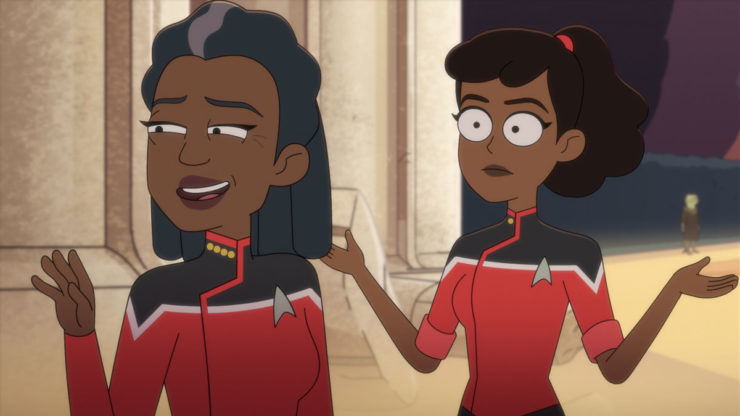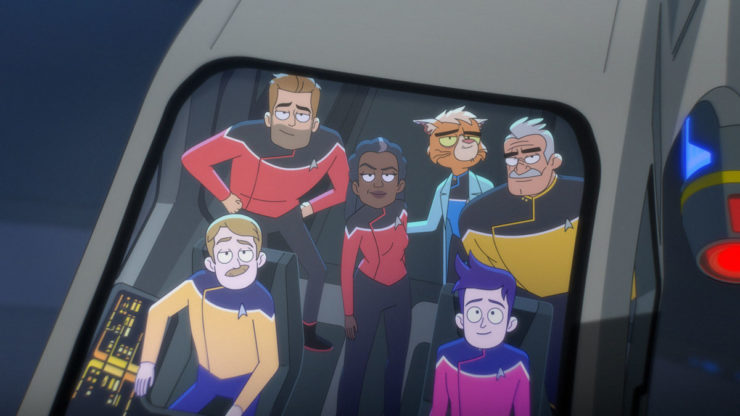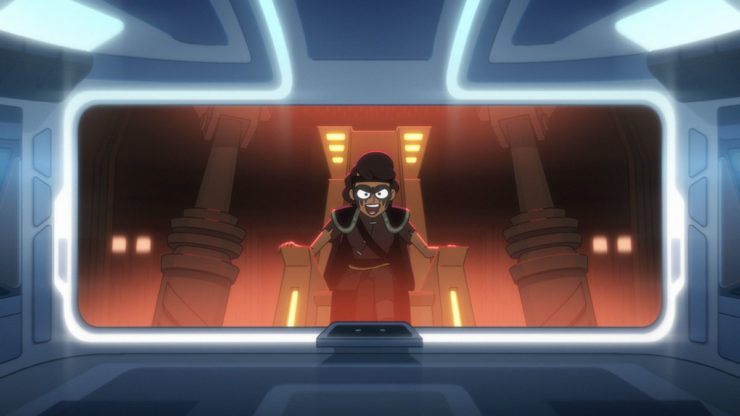It only took nine episodes, but after eight episodes of Ensign Beckett Mariner being simply awful and horrible, we finally have her realizing that she is, in fact, awful and horrible. The “Crisis Point” in the title of this week’s Lower Decks is Mariner finally exploding, her frustrations and neuroses all coming out at once.
The form they come out in? A Star Trek movie.
[SPOILERS AHOY!]
Having failed in all her attempts to get Mariner in line, whether promoting her or throwing her in the brig, Freeman decides to send her to therapy, thus allowing us to meet a new member of the Cerritos crew, Counselor Miglivo. Miglivo a) is a bird-like alien that might be a Skorr from the animated episode “The Jihad,” which makes me fifty kinds of happy and b) constantly uses food metaphors.
Buy the Book


Remote Control
Frustrated with therapy (she literally overturns a table), Mariner goes to the holodeck, and interrupts Boimler’s sucking-up-to-the-captain holodeck program. Boimler wants to apply for a diplomacy workshop, and he’s re-created the crew in a scenario that will allow him to test out certain ways of being brilliant to the captain.
But Mariner is fed up, and takes over Boimler’s program to create a movie! There’s even opening credits that whoosh from the background to the foreground (and knock people on the head if they don’t duck fast enough).
In Mariner’s movie, the newly refitted Cerritos is sent on a mission to find a vessel masquerading as a Starfleet ship. They encounter a pirate named Vindicta—Mariner herself—and her intention is to have Tendi, Rutherford, and Boimler as her hench thugs. Boimler chooses instead to stay with the Cerritos crew, so Mariner creates Shempo, a dorky guy whom Mariner eventually phasers on a whim to teach Boimler a lesson for not playacting with her.
Tendi and Rutherford play along, at least at first, but Tendi gets fed up with Mariner stereotyping her as an Orion pirate (yes, some Orions are pirates, but she isn’t), and also with Mariner’s generally psychotic behavior.
As for Rutherford, when he realizes that he can say whatever he wants to Billups without consequence, he runs to engineering and immediately tells Billups exactly what he thinks of him: that he’s awesome and the best boss ever. The rest of the episode has Rutherford and holo-Billups bonding (including helping save the ship when it crashes).
While Boimler keeps quizzing the holodeck creations for hints on how to brown-nose Freeman (for example, Ransom assures him that making cookies will help), Mariner takes out all her frustrations on the Cerritos in general and Freeman in particular by boarding the ship and phasering everyone in her path (including Ransom, who dies of a phaser blast before he can tell Boimler what Freeman is allergic to). Mariner has gone completely overboard, well beyond her previous awful behavior, so much so that it drives Tendi off the holodeck.
There is, of course, a climactic fight between Mariner and holo-Freeman, which Mariner wins—because it’s her program—but before she can deliver the killing blow by cathartically stabbing her own mother, the holodeck version of Mariner herself shows up and beams holo-Freeman to safety. In the end, the Cerritos crash-lands on the planet, though Rutherford and holo-Billups are able get everyone safely off.

Mariner and holo-Mariner fight to a standoff—they each know each other’s moves—but holo-Mariner has the psychological advantage because she brings up her self-destructive tendencies and her self-sabotage and how she actually likes it on the Cerritos but she keeps screwing it up, and that Freeman isn’t trying to screw with her, the captain is looking out for her daughter.
In the end, holo-Mariner wins the fight by blowing up the Cerritos, which causes the program to end and Mariner to realize she’s been acting like a crazy person. She, Tendi, and Rutherford go to the bar to relax. Mariner apologizes to Tendi and also is nice to Freeman (which confuses and annoys Freeman, thinking it’s another of Mariner’s tricks).
However, Boimler goes back into the program, hoping to find out more about Freeman for his interview, only to see the movie finish with a memorial service for holo-Mariner, with a eulogy given by holo-Freeman where she admits that Mariner is her daughter. This completely messes with Boimler’s entire worldview, especially since holo-Freeman says that if anyone had found out while holo-Mariner was alive, the captain would probably have them kicked off the ship in order to protect her daughter. Boimler is now a complete wreck, and he blows the interview for the diplomacy workshop. Because Boimler can’t have nice things.
The real test will be the season finale next week. Boimler now knows the Freeman-Mariner family’s deep dark secret, and Mariner supposedly has achieved some manner of (excessively overdue) enlightenment. Mariner’s idiocy has gone well beyond tiresome at this point, and we really need her to move forward before the season concludes.
But getting there is tremendous fun. TNG’s introduction of the holodeck as a regular thing (after we got it as a one-off in the animated series episode “The Practical Joker”) kept things very staid and boring and harmless. Just as Quark’s holosuites on DS9 finally copped to one of the most likely uses of the holodeck technology would be lots and lots of sex, “Crisis Point” also gives us the use of cathartic, consequence-free violence as a therapeutic tool. (We kind of saw that in First Contact, but it wasn’t nearly as therapeutic as it could’ve been, plus it wasn’t consequence-free, either.)
My favorite was still Rutherford, though. One other thing TNG showed us in “Hollow Pursuits” was that the holodeck allowed you to speak your mind to superior officers also without consequence, but where Barclay got to tell off Riker and La Forge, Rutherford simply takes advantage of the opportunity to absolutely gush at Billups. It’s hilarious, and one of the best moments of the episode.
Well, okay, my real favorite was how much fun they made of Star Trek movies. We had the following:
- A long, masturbatory look at the Cerritos by the senior crew (and Boimler) flying around it forever and ever while gaping at it, straight out of The Motion Picture. (Thankfully, it’s only for one minute instead of the nightmarish, endless four-minute-and-forty-four-second disaster from 1979.)
- Mariner as Vindicta taunting Freeman over the viewscreen, and quoting ancient literature at her, straight out of The Wrath of Khan (though Mariner quotes Shakespeare rather than Melville).
- The ship self-destructing and falling out of orbit with the saucer section on fire, straight out of The Search for Spock.
- The tag has Mariner as Vindicta in a torpedo tube on a lush planet, akin to the scene with Spock’s coffin at the end of The Wrath of Khan, with Vindicta breaking loose as Spock did in The Search for Spock. (However, holo-Leonardo da Vinci stops her in her tracks.)
- Mariner fights a doppelgänger of herself, straight out of Kirk’s fight against Martia in The Undiscovered Country. In addition, before the closing credits, we get the movie “cast” autographs, just like the actors did at before the credits of the sixth film.
- The saucer crash-lands on the planet, just like in Generations.
- There’s a climactic catwalk fight, just like in Insurrection.
- And finally, when holo-Freeman first boards the Cerritos after the masturbatory flyby, we get lots and lots of lens flares! Just like in the 2009 Star Trek!
Just like last week, we have really only one plot instead of trying to stuff a B- and C-plot in, and the episode is stronger (and funnier) for it.

Random thoughts:
- The teaser has Mariner liberating the Selay from the Anticans, two warring species we first met in TNG‘s “Lonely Among Us.” Freeman has to walk back Mariner’s violation of the Prime Directive, which leads to another argument. Mariner thinks the Selay shouldn’t be the Anticans’ food (and she’s right), but Freeman also can’t abide by interfering in a sovereign world’s politics. While in the abstract, I’m on Mariner’s side here, Freeman then comes up with a very Trek solution: “Will you stop eating them if we give you food replicators?” Problem solved, no violence.
- Tendi and Rutherford are skeet-shooting with Leonardo da Vinci on the holodeck. I was disappointed that they didn’t get John Rhys-Davies back to voice Leonardo, instead giving him a comedy Italian accent, but it was still a nice call-back to one of Janeway’s favorite holodeck scenarios.
- Counselor Miglivo’s constant use of food metaphors would’ve been way funnier if Mariner hadn’t said he always uses food metaphors before we even met him. Assuming your audience isn’t bright enough to figure out what’s funny and so telling them what’s funny makes your jokes about 75% less funny.
- On the one hand, Boimler torpedoing his interview because he accidentally learned Mariner’s parentage is an annoying construction to keep him from getting what he wants. On the other hand, he only found out because he’s trying too damn hard to suck up instead of just telling the captain his strengths, so his own overeagerness is what does him in. Again. While Mariner not learning from her idiocy is the most tiresome aspect of the show, Boimler’s inability to get out of his own way is a close second, and I hope that, too, takes some steps toward resolution next week.
- To test Boimler’s theory that the holographic versions of the crew will respond the same way they would in real life, Rutherford greets Shaxs, who snaps, “Don’t talk to me, I’m pissed off!” Rutherford then assures Boimler that he and Shaxs had that exact same conversation an hour ago.
- My actual favorite joke of the episode was Mariner insisting that “it’s the eighties, dude, we don’t have psychiatric problems!” This mention that it’s the 2380s is a nice riff on the fact that TNG debuted in the 1980s, and one of the hallmarks of that decade was the start of the mainstreaming of therapy as something not just for “crazy people,” but a useful diagnostic tool for anyone, which is why there was a therapist, not only on the ship, but sitting on the bridge next to the captain.
Keith R.A. DeCandido‘s latest book is on sale soon from eSpec Books: To Hell and Regroup, written with David Sherman, the final book in Sherman’s “18th Race” trilogy of military science fiction novels. Ordering information here.










